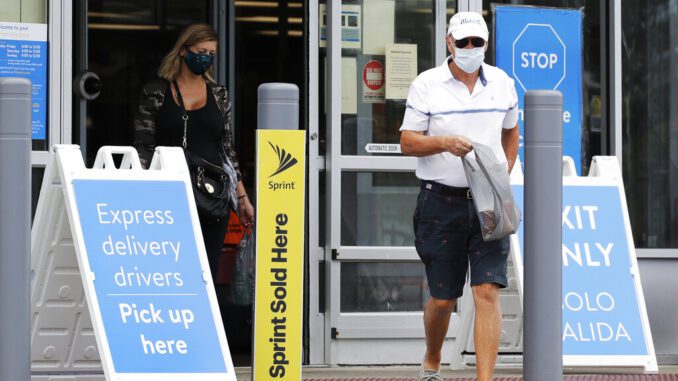
NEW YORK — Walmart raised its sales outlook for the year as Americans returned to shopping for back-to-school clothes and travel goods during the second quarter.
Still, concerns are mounting over how shoppers will behave in the months ahead as the delta variant of COVID-19 surges across the U.S. and mask mandates are reinstated. On top of that, higher prices on everything from food to automobiles are making shoppers more conscious about spending. And temporary government stimulus and other benefits, which helped prop up overall spending, are dissipating.
Other major retailers are reporting quarterly results this week and next, and there is early evidence that behaviors that changed vastly during the pandemic, have begun to change again, or at least normalize.
Data from Home Depot, which also reported earnings Tuesday, showed that traffic in stores fell a bit after a massive rush of DIY projects during lockdowns. At Walmart, the blistering growth in online orders has slowed drastically.
Also on Tuesday, the U.S. reported that retail sales in July fell a seasonal adjusted 1.1%. It was a much larger drop than the 0.3% decline Wall Street analysts had expected. According to Tuesday’s report, spending fell at stores that sell clothing, furniture and sporting goods.
“There is now a very clear sign that the momentum, which has propelled the sector over the few months or so, is slowing and that growth rates are moderating as a result,” said Neil Saunders, managing director of GlobalData Retail. “To be clear, this is not catastrophic and it in no way signals anything near a contraction for retail.”
Saunders noted that the savings rate remains high, which means “better-off households” still have a buffer of cash.
It was yet another strong quarter for Walmart, which has been able to retain customers who rely on its stores, curbside pickup services, as well as delivery.
Walmart reported earnings of $4.27 billion, or $1.52 per share, during the three-month period ended July 31. That is a nickel better per share than Wall Street had expected, according to a survey by FactSet.
Net profit last year was $6.47 billion, or $1.77 adjusted per share.
Sales in the most recent quarter rose 2.2% to $139.87 billion, also better than the $137. billion industry analysts expected.
Comparable sales at U.S. stores rose 5.2%, a bit of a slowdown from the 6% increase in the first quarter. Online sales growth dramatically slowed to 6%, but that’s compared with last year when the pandemic shocked the U.S., and Walmart’s online orders surged 97%. There was a 37% increase in the first quarter and 69% increase in the fourth quarter.
Company executives told analysts Tuesday that shoppers went to stores for items like party supplies, luggage and clothing. For back-to-school, customers bought backpacks and paper supplies in addition to fashion.
Walmart is facing rising costs for everything from labor to shipping as supply chain back-ups hit companies worldwide. Brett Biggs, Walmart’s chief financial officer, said Tuesday that the company is monitoring transit and port delays. Walmart is also chartering vessels for Walmart goods as it heads into the fall and holiday shipping crunch, Biggs said.
Home Depot also has secured its own transportation and Amazon.com has long pushed for autonomy in shipping.
Walmart now says that it expects sales at stores opened at least a year to be up 5% to 6% for the year; it had previously said the metric would be up in the low single digits.



